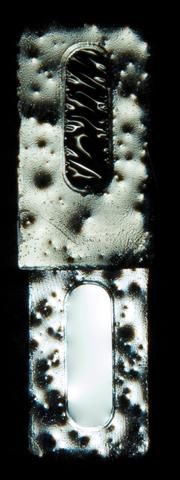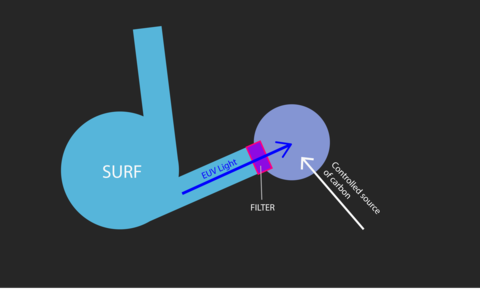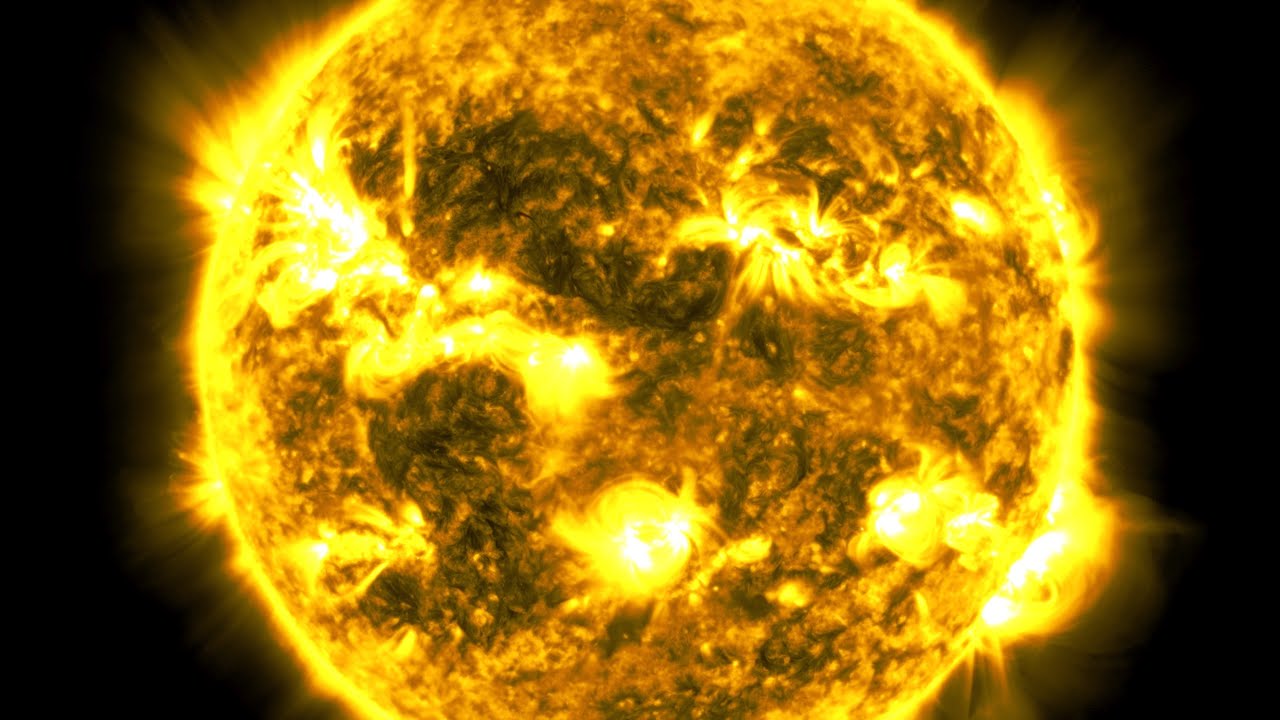
Two EUV filters that were used in a space flight. The wrinkly looking filter on top is made of zirconium; the smoother bottom filter is made of aluminum. Each filter is extremely thin – a fraction of the diameter of a human hair – and about 1.4 mm wide by 4.5 mm long, roughly half the size of a very flat Tic Tac.
More than 150 years ago, the Sun blasted Earth with a massive cloud of hot charged particles. This plasma blob generated a magnetic storm on Earth that caused sparks to leap out of telegraph equipment and even started a few fires. Now called the Carrington Event, after one of the astronomers who observed it, a magnetic storm like this could happen again anytime, only now it would affect more than telegraphs: It could damage or cause outages in wireless phone networks, GPS systems, electrical grids powering life-saving medical equipment and more.
Sun-facing satellites monitor the Sun’s ultraviolet (UV) light to give us advance warning of solar storms, both big ones that could cause a Carrington-like event as well as the smaller, more common disturbances that can temporarily disrupt communications. One key piece of equipment used in these detectors is a tiny metal filter that blocks out everything except the UV signal researchers need to see.
But for decades, there has been a major problem: Over the course of just a year or two, these filters mysteriously lose their ability to transmit UV light, “clouding up” and forcing astronomers to launch expensive annual recalibration missions. These missions involve sending a freshly calibrated instrument into space to make its own independent observations of the sunlight for comparison.
A leading theory has been that the filters were developing a layer of carbon, whose source is contaminants on the spacecraft, that blocked incoming UV light. Now, NIST scientists and collaborators from the Laboratory for Atmospheric and Space Physics (LASP) in Boulder, Colorado, have found the first evidence indicating that carbonization is not the problem, and it must be something else, such as another possible stowaway from Earth. The researchers describe their work in Solar Physics today.
“To my knowledge, it’s the first quantitative, really solid argument against carbonization as the cause of the filter degradation,” said NIST physicist Charles Tarrio.
What Are They Good For? Absolutely Everything
Most of the light produced by the Sun is visible and includes the rainbow of colors from red (with a wavelength of around 750 nanometers) to violet (with a wavelength of about 400 nm). But the Sun also produces light with wavelengths too long or short for the human eye to see. One of these ranges is extreme ultraviolet (EUV), extending from 100 nm down to just 10 nm.
Only about a tenth of a percent of sunlight is in the EUV range. That tiny EUV signal is extremely useful because it spikes in tandem with solar flares. These eruptions on the surface of the Sun can cause changes to Earth’s upper atmosphere that disrupt communications or interfere with GPS readings, causing your phone to suddenly think you are 40 feet away from your true location.
Satellites that measure EUV signals help scientists monitor these solar flares. But the EUV signals also give scientists a heads-up of hours or even days before more destructive phenomena such coronal mass ejections (CMEs), the phenomenon responsible for the Carrington Event. Future CMEs could potentially overload our power lines or increase radiation exposure for airline crew and passengers traveling in certain locations.
And nowadays, the satellites do more than merely give us warnings, said LASP senior research scientist Frank Eparvier, a collaborator on the current work.
“In the past few decades we’ve gone from just sending out alerts that flares have happened to being able to correct for solar variability due to flares and CMEs,” Eparvier said. “Knowing in real time how much the solar EUV is varying allows for the running of computer models of the atmosphere, which can then produce corrections for the GPS units to minimize the impacts of that variability.”
The Mystery of the Cloudy Filters
Two metals are particularly useful for filtering out the massive amounts of visible light to let through that small but important EUV signal. Aluminum filters transmit EUV light between 17 nm and 80 nm. Zirconium filters transmit EUV light between 6 nm and 20 nm.
While these filters begin their lives transmitting a lot of EUV light in their respective ranges, the aluminum filters, in particular, quickly lose their transmission abilities. A filter might start by allowing 50% of 30-nm EUV light through to the detector. But within just a year, it only transmits 25% of this light. Within five years, that number is down to 10%.
“It’s a significant issue,” Tarrio said. Less light transmitted means less data available — a little like trying to read in a dimly lit room with dark sunglasses.
Scientists have long known that carbon deposits can build up on instruments when they are subjected to UV light. Sources of carbon on satellites can be everything from fingerprints to the materials used in the construction of the spacecraft itself. In the case of the mysteriously cloudy UV filters, researchers thought carbon might have been deposited on them, absorbing EUV light that would otherwise have passed through.
However, since the 1980s, astronomers have been carefully designing spacecraft to be as carbon-free as possible. And that work has helped them with other carbonization problems. But it didn’t help with the aluminum EUV filter issue. Nevertheless, the community still suspected carbonization was at least partially responsible for the degradation.
Make-Your-Own Space Weather
To test this in a controlled setting, NIST researchers and collaborators used a machine that effectively lets them create their own space weather.

The instrument is NIST’s Synchrotron Ultraviolet Radiation Facility (SURF), a room-sized particle accelerator that uses powerful magnets to move electrons in a circle. The motion generates EUV light, which can be diverted via specialized mirrors to impact targets — in this case, the aluminum and zirconium satellite filters.
Each filter was 6 millimeters by 18 mm, smaller than a postage stamp, and only 250 nm thick, about 400 times thinner than a human hair. The sample filters were actually slightly thicker than real satellite filters, with other small changes designed to prevent the SURF beam from literally burning holes into the metals. During a run, the back side of each filter was exposed to a controlled source of carbon.
To speed up the testing process, the team blasted the filters with the equivalent of five years’ worth of space weather in a mere hour or two. Incidentally, getting that kind of beam power was no sweat for SURF.
“We turn SURF down to about half a percent of its normal power in order to expose the filters to a reasonable amount of light,” Tarrio said. “The satellites are 92 million miles away from the Sun, and the Sun’s not putting out an awful lot of EUV to begin with.”
Finally, after exposure, researchers tested each filter to see how much EUV light in the correct wavelength range was able to pass through.
The team found that transmission was not significantly different after exposure versus before exposure, for either the aluminum or the zirconium. In fact, the difference in transmission was just a fraction of a percent, not nearly enough to explain the kind of clouding that happens in real space satellites.
“We were looking for a 30% decrease in transmission,” Tarrio said. “And we just didn’t see it.”
As an extra test, the scientists gave the filters even larger doses of light — the equivalent of 50 years’ worth of ultraviolet radiation. And even that didn’t produce much of a light transmission problem, growing just 3 nm of carbon on the filters — 10 times less than researchers would have expected if carbon was responsible.
So If It’s Not Carbon …
The real culprit hasn’t yet been identified, but researchers already have a different suspect in mind: water.
Like most metals, aluminum naturally has a thin layer on its surface of a material called an oxide, which forms when aluminum binds with oxygen. Everything from aluminum foil to soda cans has this oxide layer, which is chemically identical to sapphire.
In the proposed mechanism, the EUV light would pull atoms of aluminum out of the filter and deposit them on the filter’s exterior, which already has that thin oxide layer. The exposed atoms would then react with the oxygen in water from Earth that has hitched a ride on the spacecraft. Together, the exposed aluminum and water would react to form a much thicker oxide layer, which could theoretically be absorbing the light.
Further SURF experiments scheduled for later this year should answer the question of whether the problem really is water, or something else. “This would be the first time that people have looked at the deposition of aluminum oxide in this context,” Tarrio said. “We’re looking into it as a serious possibility.”
-- Reported and written by Jennifer Lauren Lee
Paper: C. Tarrio, R.F. Berg, T.B. Lucatorto, F.G. Eparvier, A.R. Jones, B. Templeman, D.L. Woodraska, and M. Dominique. "Evidence Against Carbonization of the Thin-Film Filters of the Extreme Ultraviolet Variability Experiment onboard the Solar Dynamics Observatory." Solar Physics. DOI: 10.1007/s11207-021-01806-4


